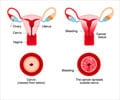A new method to monitor early sign of oxidative stress that triggers cancer spread has been developed by scientists from University of Michigan.
Lead researcher Kate Carroll suggests that being able to monitor a marker of oxidative stress that is associated with the activation of tumor cell growth pathways, particularly at an early stage, and then tailor treatments accordingly would allow for more targeted studies and might improve the odds of success with antioxidants and pro-oxidants.The new method detects sulfenic acid in proteins-a tip off to early oxidative stress and to a specific protein modification associated with cell growth pathways.
Sulfenic acid is produced when a particular oxidant, hydrogen peroxide, reacts with the protein building block cysteine. But because the chemical modification involved is so small and transient, it has been difficult to detect.
To get around that problem, Carroll and Seo used a chemical probe that "traps" sulfenic acid and tags it for recognition by an antibody.
The antibody is labeled with a fluorescent dye that glows when observed with a fluorescence microscope.
The researchers then used the method to assess sulfenic acid levels as a marker of oxidative stress in several systems, including a panel of breast cancer cell lines.
Advertisement
"Whether the patterns we see will correlate with response to antioxidant treatment or other therapies that modulate oxidative stress level remains to be seen, but now we at least have a way to investigate that question," the expert added.
Advertisement
Source-ANI
RAS















